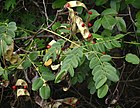Note: This is a project under development. The articles on this wiki are just being initiated and broadly incomplete. You can Help creating new pages.
Difference between revisions of "Adenanthera pavonina - Ksharaka"
(→Photo Gallery) |
|||
| Line 69: | Line 69: | ||
<gallery class="left" caption="" widths="140px" heights="140px"> | <gallery class="left" caption="" widths="140px" heights="140px"> | ||
File:Adenanthera pavonina seeds.jpg|Seeds | File:Adenanthera pavonina seeds.jpg|Seeds | ||
| − | + | Image:Adenanthera pavonina.jpg|Leaves | |
| − | |||
</gallery> | </gallery> | ||
Revision as of 15:38, 26 April 2019
Ksharaka, Adenanthera pavonina is a fast-growing deciduous tree with a spreading crown of light, feathery foliage. The tree is widely cultivated in the tropics for a wide range of uses. A very ornamental plant with fragrant, creamy flowers, it is often grown as a specimen and as a street tree.
Contents
- 1 Uses
- 2 Parts Used
- 3 Chemical Composition
- 4 Common names
- 5 Properties
- 6 Habit
- 7 Identification
- 8 List of Ayurvedic medicine in which the herb is used
- 9 Where to get the saplings
- 10 Mode of Propagation
- 11 How to plant/cultivate
- 12 Commonly seen growing in areas
- 13 Photo Gallery
- 14 References
- 15 External Links
Uses
Arthritis, Burning sensation, vomiting, fever, Hemorrhoids [1]
Parts Used
Bark, Leaves, Heartwood, Seeds
Chemical Composition
Common names
| Language | Common name |
|---|---|
| Kannada | aane gulaganji |
| Hindi | baragunci, barighumchi, barigumchi |
| Malayalam | manjadi |
| Tamil | aanaikundrimani, anai kundumani |
| Telugu | bandi gurivenda, bandi gurvina, bandigurivenda, bandiguruginja, enugaguruginji |
| Marathi | NA |
| Gujarathi | NA |
| Punjabi | NA |
| Kashmiri | NA |
| Sanskrit | kamboji, ksharaka, kucandanah,tamraka |
| English | Coralwood tree |
Properties
Reference: Dravya - Substance, Rasa - Taste, Guna - Qualities, Veerya - Potency, Vipaka - Post-digesion effect, Karma - Pharmacological activity, Prabhava - Therepeutics.
Dravya
Rasa
Tikta (Bitter)
Guna
Laghu (Light)
Veerya
Sheeta (cold)
Vipaka
Karma
Pitta
Prabhava
Habit
Identification
Leaf
| Kind | Shape | Feature |
|---|---|---|
| Bipinnate | alternate | Leaves bipinnate, alternate, stipulate, rachis 14.5-62.5 cm long, stout, with a gland at the tip. Pinnae 2-3 pairs, leaflets 8-20, alternate |
Flower
| Type | Size | Color and composition | Stamen | More information |
|---|---|---|---|---|
| Bisexual | axillary spiciform racemes | Pale yellow | 10 | Flowering and fruiting is from January to September |
Fruit
| Type | Size | Mass | Appearance | Seeds | More information |
|---|---|---|---|---|---|
| A Pod | 10-25 x 0.7-1.5 cm | Follicle 2-angled, acute, straight to falcate to slightly twisted, spirally coiled after dehiscence | seeds 6-15, 8-10 x 7-9 mm, glossy, red | {{{6}}} |
Other features
List of Ayurvedic medicine in which the herb is used
Where to get the saplings
Mode of Propagation
How to plant/cultivate
Season to grow
Soil type
Propagation
Commonly seen growing in areas
Photo Gallery
References
External Links
- Ayurvedic Herbs known to be helpful to treat Arthritis
- Ayurvedic Herbs known to be helpful to treat Burning sensation
- Ayurvedic Herbs known to be helpful to treat vomiting
- Ayurvedic Herbs known to be helpful to treat fever
- Ayurvedic Herbs known to be helpful to treat Hemorrhoids
- Herbs with Bark used in medicine
- Herbs with Leaves used in medicine
- Herbs with Heartwood used in medicine
- Herbs with Seeds used in medicine
- Herbs with common name in Kannada
- Herbs with common name in Hindi
- Herbs with common name in Malayalam
- Herbs with common name in Tamil
- Herbs with common name in Telugu
- Herbs with common name in Sanskrit
- Herbs with common name in English
- Habit - Tree
- Index of Plants which can be propagated by Seeds
- Index of Plants which can be propagated by Cuttings
- Herbs that are commonly seen in the region of Tropical area
- Herbs
- Plants of western ghats
- Tree


